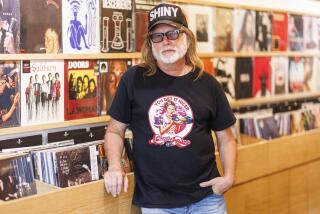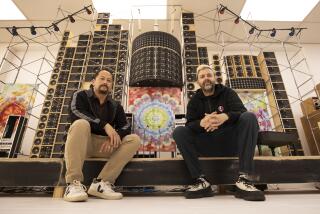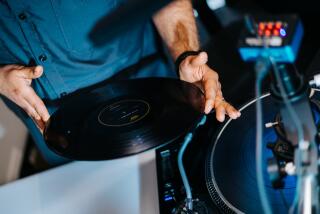THE GOODS : New Spin for Vinyl : Remember the albums you have stacked away? Now you can clean up the clicks, pops and other noises for a warm reunion with the music you love.
With a plastic squeeze bottle in one hand and an RCA Victor long-playing record in the other, Randy Cooley demonstrates the Nitty Gritty Record Cleaning System, contained in a modest plastic and wooden box.
âIt wonât get rid of scratches, but the pops, clicks and surface noises will fade away,â he says, carefully placing the LP onto a spindle in the machine.
He squeezes fluid onto a brush, sloshes it on the record surface, turns the record over and rotates it by hand, to a slurping sound--the sound of a vacuum brush suctioning every groove of the record clean and dry.
Cooley was demonstrating an insiderâs secret: It is possible to make many old LP records sound like new. As owner of Optimal Enchantment, a small Santa Monica shop specializing in upscale audio equipment and used records, he runs all his LPs through the machine.
This and other specialized technology, such as new cartridges and turntables, provide the answer to the LP dilemma: What to do with those beloved jazz, classical or old rock albums--sentimental journeys you canât bear to throw out--that got shoved into the closet when the trendy little CD player moved in.
Cooley sees many customers who reluctantly bring in their record collections to sell. âBecause of the industry hype, people assume LPs arenât as good as CDs, so they get rid of them, or never play them,â he says. âIt makes me happy because I can buy them, but it also makes me sad, because they are selling their emotions.â
In addition to sentiment, there is music that is available only on vinyl. âThere are many esoteric things from the â50s that werenât reissued on CD,â one audio dealer says. âLetâs be honest--how much can a store hold? If you want to hear Frankie Laine doing âGhost Riders in the Sky,â I think it has to be on a record.â
It will take some time and money, but you can rejuvenate your LP listening pleasure. The starting point is the cleaning machine, long used by collectors.
âItâs the best way to revive a record,â says Mark Lehman of Cincinnati, a college English teacher and serious record collector with a library of more than 6,000. Although the record-cleaning machine has limits--âIt canât do anything for scratches or wear,â he says--it will take off the accumulated dust and grit that gum up record grooves and interfere with sound.
The machines work like this: The record is doused with a special fluid and scrubbed with a brush whose microscopic fibers loosen all the film, grease, dust, mold and carbon fibers in the grooves. Then the record is rotated over a vacuum motor that sucks every groove dry and clean. Adaptors for 45 and 78 rpm records are available.
The two commercial manufacturers of record cleaning machines--Nitty Gritty Record Care Products Inc. (price range: $239 to $759) and VPI Industries Inc. (price range: $450 to $900)--are small operations in a market that expects to sell 23 million compact disc players this year. âThis is the best-kept secret in the whole world,â says Mike Randall of VPI in Cliffwood, N.J., which has been making record cleaning machines since 1978.
Although the machines have been favorably reviewed in specialized audio magazines, these reach only about 300,000 readers, he says, a small number in the scope of things. âThere are probably 3 billion records out there.â
And most of them, he says, are dirtier than their owners think. âIf you went to college you had records in the dorm, flipped them around from room to room. You probably got pizza on them. We get letters from people who buy this machine and they clean off things that have been on the record for 50 years.â
A good cleaning, Randall says, can be a rediscovery. âPeople are finding out how really good records are--the finest records ever made were in the late â50s. I think weâre in a kind of little vinyl renaissance.â
At Nitty Gritty in Montclair, Gayle Van Syckle agrees with Randall that vinyl is not dead. âWe have a number of different models and probably sell a thousand record-cleaning machines a year. Itâs a specialized product, though. You arenât going to find it in Circuit City.â
Audio writer Corey Greenberg, who reviewed a Nitty Gritty and a VPI for the May issue of Stereophile magazine, says he was astounded by the âleapfrog improvementâ in his records both in sound resolution and tonal balance.
âIâve tried better turntables, arms, cartridges, pre-amps, cables and isolation schemes,â he writes.
âWhile all of them have improved the sound of my records, none have ever given me the kinds of improvements in noise reduction, clarity and elimination of mid-to-treble ringing that these record-cleaning machines have.â
*
Greenberg, a former broadcast engineer, reviewed a $450 model in each line. âBoy, itâs like getting a new system,â Greenberg said in a phone interview. âFor years I really pooh-poohed the notion of these things. For me, $450 is not a small piece of change. But you can also buy the Nitty Gritty for around $240, if you donât mind turning the record by hand.â
Now for ways to make your newly clean records sound even better. Despite the dominance of CDs, the past decade has seen continued progress in LP playback technology. Audio shops are stocking new turntables, new cartridges and even new recordings.
Says Charles Back, an executive at Miller and Kreisler Sound in Los Angeles: âIt happens because there is a community of people, the high-end audiophile contingent, who strongly prefer the sound of records and continue to pursue and support this technology.â
Some of the equipment is esoteric. Such turntable improvements as minimizing micro-vibrations or upgrading control on disc-rotation speed are for the purist, Back acknowledges. But there are also technologies that would please a mainstream listener:
* A new cartridge will translate the sound better than your old one. The technology in cartridges has changed dramatically in the last 10 years. The modern stylus tracks lighter, so you may play in less worn parts of the grooves than with your old machine. A $30 Grado is considered an excellent entry-level cartridge in a field that can go to $2,500 for a Linn Arkiv.
* A new entry-level turntable with arm, such as a Sota Comet (about $550) or VPI ($700) can make an amazing difference in sound, particularly if your present turntable is the sort of $250 Sears special that dominated the last mass market of the early â80s.
* If you must choose one or the other, put a cheap cartridge in a good turntable, rather than the other way around. Cartridge performance is limited by turntable and arm vibrations. Get your dealerâs advice on matching.
* If you canât afford a record-cleaning machine, a commercial hand-held brush, available for $15 to $20, is better than nothing.
* If you buy a cleaning machine but donât want to buy the cleaning fluid ($60 a gallon, which will clean 800 to 1,000 records), here is Mark Lehmanâs recipe to make your own: Stir together four pints of distilled water, one pint of isopropyl alcohol (90% solution or better) and three or four drops of Photo-flow, available at photography supply shops, or Windex.
*
To keep records in optimum playing condition, handle them carefully without getting fingerprints on them. Put one at a time on the turntable, not a spindle-load. Store records properly. Paper liners wonât keep grit out. Buy plastic-lined paper, and keep records in the album covers. Stack albums vertically in a cool dry place.
Lots of people are making fresh starts with LPs, says Brooks Berdan of Monrovia, a longtime turntable designer and consultant who sells upscale equipment.
He suggests a $1,000 package as a starting point. For that price he recommends a VPI HW 19 Jr. turntable, an Audioquest PT6 tone arm and a Bluepoint cartridge. âThatâs a popular package.â
Want to go all out? Berdan mentions an Immedia RPM-2 turntable, Graham tone arm and Lyra Parnassus cartridge. âWeâre probably talking $11,000,â he says. âAnd there are certainly price tables in-between.â
At whatever level you can afford, what you are buying is a warm reunion, Berdan says: âPeople call me and say theyâve discovered their record collections all over again.â
âBecause of the industry hype, people assume LPs arenât as good as CDs, so they get rid of them, or never play them. It makes me happy because I can buy them, but it also makes me sad, because they are selling their emotions.â Randy Cooley, Owner of Optimal Enchantment
More to Read
The biggest entertainment stories
Get our big stories about Hollywood, film, television, music, arts, culture and more right in your inbox as soon as they publish.
You may occasionally receive promotional content from the Los Angeles Times.










